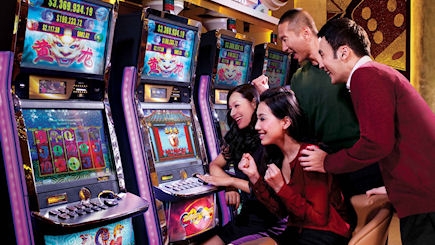This article first appeared in the Jan/Feb 2013 issue of World Gaming magazine.
The humble slot machine has come a long way. Incredible free game features, linked jackpots and state-of-the-art animation have replaced the old-school lucky 7s and cherries. Be prepared to be entertained.

The Terminator movies predicted a future where machines would rule the world. The machines became so sophisticated that human thought and control was no longer needed. Obviously the world of gaming isn’t heading down that road just yet but the age of the machines is here and no one appears to have any problems.
In Macau’s casino gaming environment there are two boom commodities: baccarat and slot machines. With all due respect to the rest of the games, the Macau table cap is ensuring they are all dying slow deaths. You are always going to find blackjack, roulette and craps in casinos but, given the current rules in place, the Macau of the future won’t have many such tables and you might find them being run by computer-generated dealers or in stadium seating with betting terminals. Casinos are businesses and good businesses offer what their clientele wants. Punters want more baccarat and exciting new slots.
Technology develops most efficiently when there is demand. For example, the biggest leap forward in weaponry is during wartime because there is a need for it. The slot machine continues to develop at an incredible rate as demand is high and the marketplace is hungry for better features, more action and more entertainment. To understand just how far electronic gaming has come, let’s start by taking a look at the history and evolution of slots. Believe it or not the story starts 130 years ago!
How it all began
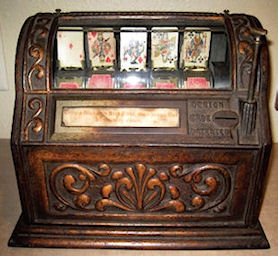
The Sittman and Pitt card machine appeared in 1891
In 1891 the Sittman and Pitt card machine appeared in bars around Brooklyn in New York City. Players inserted a nickel for the right to press a long metal plunger, which then brought up five random playing cards, forming a poker hand. Winning hand combinations were paid at bar management discretion – perhaps a free beer for a pair of jacks or better, perhaps a free meal for a flush. This machine can’t really be described as a slot machine, because it had no payout mechanism, but it was certainly a precursor to the industry’s development.
The Liberty Bell
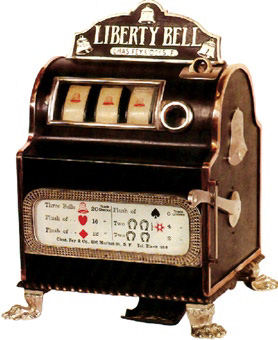
The first true slot machine, the Liberty Bell
The first ever machine universally acknowledged as a slot machine was invented in San Francisco by Charles Fey in 1895. Fey, a German who had immigrated to the US, named his machine the “Liberty Bell”. The cast-iron machine sat on a counter or bench, and had three reels each with ten stops. Each stop had a symbol (diamonds, hearts, spades, a horseshoe or a picture of a cracked Liberty Bell). Players would bet by dropping a nickel into a coin acceptor, also known as a “coin slot”, thus forever immortalizing the term “slot machine”. They then pulled a handle, spinning the reels. Each reel stopped randomly, and if all three reels lined up with the same symbol, the player won a prize, which was ejected into a small coin tray at the bottom of the machine. The biggest payout, ten nickels, was reserved for three Liberty Bell symbols.
The Liberty Bell was incredibly popular and many companies soon copied Fey’s invention. In less than a decade upright machines that stood on the floor started to appear. The legs of these machines were to eventually evolve into custommade wooden cabinets, which held much of the devices’ internal workings.
Slot machines spread in the ensuing decades, with new manufacturers being established and many new game themes being developed. However, the basic design of these “bell-type” slot machines remained relatively unchanged until the 1960s.
Electronics Arrive
The introduction of electronics was a revolution for the slot machine. The first electromechanical machines looked very similar to the fully mechanical machines, but as the years went by the mechanical lever gave way to electrical buttons. Even today, some slot machines have an arm, but this is just a vestige and pulling the arm merely operates an electronic switch that makes the reels spin.
In the 1970s, video poker arrived. This machine had no arm, and was completely electronic. Based on the card game of draw poker, players would be “dealt” five cards and choose which to hold and which to discard, and then draw replacements for the discarded cards. This added the extra twist of giving the players a decision to make, changing the game from one of pure luck to a game where the skill of a player affected his chance of winning. This “game control” was such a hit with the players that slot machine manufacturers now try to build the “illusion of control” into many machines that in reality are matters of pure luck.
The CPU changes everything

Mr David Punter
Mr David Punter is General Manager Asia Pacific for Aristocrat Macau, a dominant electronic gaming machine manufacturer in Macau. We asked him about the changes to slots in the 1980s and he explained:
The move to video and digital from hard stepper style games allowed creative games designers to bring more features and entertainment to the marketplace. You get a lot more processing power from modern computers. Technological advances have allowed fancier graphics, symbols and sounds.
Some of the many new developments included:
- Physical spinning reels were replaced by video reel games with virtual reel stops, thus vastly increasing the number of reel stop combinations, and therefore the maximum prizes the machines could offer.
- Advanced aesthetic design with a wide range of colors, animation and enhanced sound. Artwork moved from being fixed on physical components to being animated on screens.
- The expansion of two-way communication between the machine and the player for many different styles of game. Previously this kind of interaction had been limited to video poker.
- Scope for bonus reels, bonus play and more flexibility, creativity and complexity in game design and play. This type of advanced game design really started to emerge in the 1990s (see discussion later in this article).
- An expansion of video poker from a simple one-hand one-style game to a rich suite of games. Draw poker games evolved to play as many as 100 hands per game, and various wild card rule sets were developed, such as decks with jokers and deuces wild. This created many more winning combinations. For example, it was now possible to create a very high payout for the extremely rare five-of-a-kind results.
- Although there had been some mechanical credit meters since the late 1960s, widespread use of electrical credit meters began in the mid 1980s, vastly reducing the amount of coin handling involved in playing slot machines. Prior to credit meters players had to feed coins into the machine for every bet, and received coins in the coin tray for every win.
Having a powerful CPU allowed for all sorts of new permutations and combinations. Some physical reel games got a bonus fourth reel that was activated when certain symbols or combinations were spun. The virtual reel machines, also known as the “Australian style machines” because of their popularity in that country, had microprocessors that were able to cope with literally millions of combinations, so the normal number of reels on those machines quickly became five, rather than the former industry standard of three.
David Punter further explains:
There was a shift from a low number of lines with high denominations to a high number of lines with low denominations. Denominations went from 5 cents or 10 cents down to 1 cent. We used to have a maximum of nine lines on a machine, but then we went to 243 lines (or “ways”) with our “reel power” concept. The symbols didn’t have to line up anymore so there were many more ways to win.
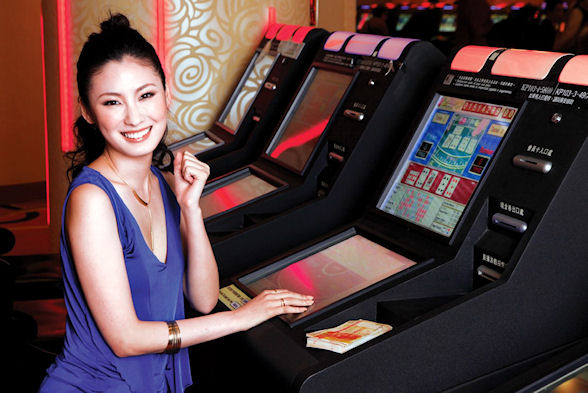
Developments were also occurring in the physical shape of slot machines. We saw the introduction of bar top machines in the early 1980s for those that like to perch themselves at a bar and drink while they played. Many a Vegas player has drunk the night away for free, his drinks comped on the basis of his action on a bar top machine. Slant top machines began to appear in the mid 1980s to accommodate players who preferred to sit in a normal chair, rather than stand or perch themselves on a high stool in front of an upright machine.
While these developments were happening in western countries like the US, Australia and the UK, the Japanese Pachinko industry closely mirrored the slots industry. Pachinkos were also entirely mechanical until the 1970s, with electrical machines offering additional features taking over from the 1980s.
Jackpots
A major development in slot machine history was the rise of jackpots. Slot players are always looking for a bigger potential prize, and jackpots created just that. There are three types of slot jackpot:
- Stand-alone progressives: These first started to appear in the 1960s. A small amount of each bet on a machine is added to the jackpot for that machine – and the jackpot can only be won on that machine. If the machine is played for long enough, the jackpot must eventually be won on it.
- Local area jackpots: Introduced in the 1970s, banks of machines are networked as a group with a small amount of each bet made on any machine in the network added to the jackpot, which can be won on any machine in the group.
- Wide area jackpots: A huge number of machines, perhaps hundreds or even thousands, are linked. These machines can be across multiple casino properties and may even be in different cities. A small proportion of each bet made on any machine in the network is added to the jackpot, and that jackpot can be won on any linked machine. Typically only maximum bets are eligible for jackpot wins. On these machines it makes no sense to bet anything other than the maximum. Because so many machines are involved, the jackpot amounts can become huge.
The most famous jackpot of all is the Megabucks wide area jackpot. It was introduced in the US in 1986, and remains popular to this day. Megabucks is responsible for all of the very biggest jackpots ever to be hit in the history of slot machines. Sands China Limited introduced its very own Macau version of Megabucks in December 2011. The Macau Megabucks jackpot currently stands at around HK$57 million, although it is yet to be won by anybody since it was introduced. The Venetian is the most popular place in Macau to play Megabucks.
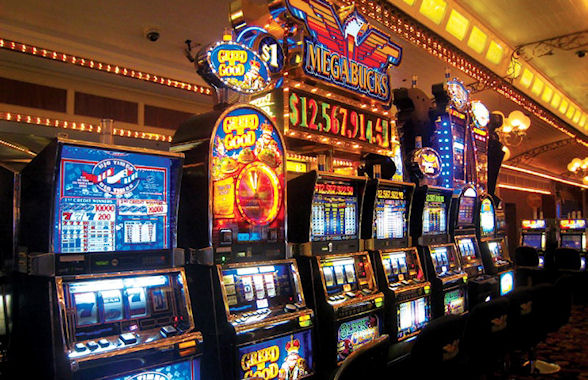
Megabucks in the United States
The biggest prize ever won on Megabucks in the US was the mind-boggling amount of US$39,710,826.36 on 21 March 2003 at Las Vegas’ Excalibur casino by a 25-year-old man who unsurprisingly preferred to remain anonymous. As with many ultra-huge jackpots, to win the US version of Megabucks you must bet the maximum bet, which is US$3. If the three Megabucks symbols line up on your playing line, you win the monster jackpot. Imagine the agony of 22-year-old Utah man Kirk Tolman, who on 14 March 2001 made the soul-destroying mistake of merely playing US$2 instead of US$3, and then proceeded to witness in horror the three Megabucks symbols line up! His US$10,000 consolation prize was probably not very consoling, given he had just witnessed US$7.96 million go down the drain.
Jackpots added a whole new life-changing dimension to slot machines, and took them from a fun amusement where players could collect a nice score, to serious business where they could win more money than many people earn in a lifetime. Sometimes jackpots are required to go off before they hit a predetermined amount, which is advertised next to the scrolling jackpot display. When the jackpot gets close to the maximum amount, the excitement and anticipation can hit fever pitch.
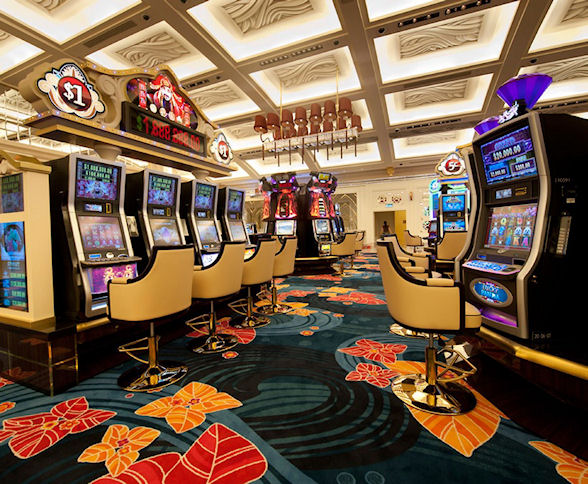
The iconic Fa Fa Fa jackpot at Galaxy Macau
Many jackpots are tiered into three or four levels, usually with names like mini, minor, major and grand. The smaller jackpots are nice little sweeteners that go off regularly, whereas the biggest jackpots occur much more rarely, but the amounts are often life changing. In Macau, the jackpot product known as “Fa Fa Fa” has traditionally been the most popular jackpot in town – regularly going off for many millions of dollars. The biggest jackpot ever won in Macau was a Fa Fa Fa jackpot hit at the Sands Macau in February last year for HK$21 million.
The demise of coins
The next major advance to occur was the development of the note acceptor, also known as a bill validator, which started to appear on machines in the early 1990s. One of the big hassles with playing slots had always been the fact that players had to change their notes for coins before playing, and their coins back to notes after cashing out. The use of the note acceptor saved having to lug heavy tubs of coins to the machine, and the use of a ticket printer (which first appeared in 1999) helped players avoid lugging heavy tubs of coins away from the machines. Now playing slots was as easy as walking up to a machine, sliding your notes in for credit, playing, and then cashing out by pushing a button and collecting a ticket which could be cashed at the casino cage, just like cashing chips.
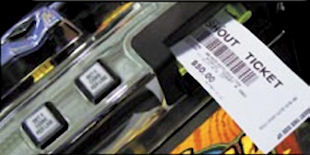
Ticket-in-ticket-out (TITO)
TITO technology was incredibly popular and quickly became ubiquitous throughout the world’s major casinos. Cashless slot systems are so common now that there are no machines left in Macau casinos that accept coins.
Other 1990s developments
The last decade of the last century saw a number of other game-changing developments to the slot industry:
- Touch screen technology
- Multiple game machines
- Interactive bonus game play (also known as “features”)
Multiple game machines addressed the issue of slot players wandering a casino floor in search of a favorite (or simply lucky) machine. With multiple game machines, players could select one of many games on their machine. Typically these machines had blackjack, keno, multiple versions of draw poker and video reel games. If a player tired of any particular game, he could change to another game without having to physically move or cash out.
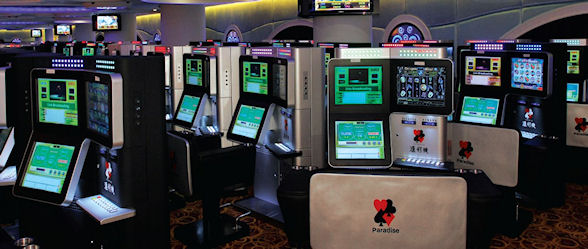
LT Game live dealer machines at Kampek casino
In 1996, Aristocrat led the industry when it released the first machine with a “feature” that captured the imagination of the gaming public. The game was released in 1996 as “Dolphin Treasure” and in 1997 as “Golden Pyramids” and also in the same year as “Queen of the Nile”. All three of these machines were the same game – they simply had different user interfaces. If three key symbols rolled anywhere onto the screen, the “feature” would be triggered and players received 15 free games. If the feature also hit again during the free games, 15 more free games would be given to the player. For more information on these games, read our article in the Nov/Dec 2010 issue of WGM. Just go to wgm8.com and type “Pyramids of gold” (with the quotes) in the search box.
These Aristocrat machine “features” were the very beginning of a wide range of bonus play enhancements, which evolved into what we often now call “second-screen play”, where the play enters an entirely different environment to the main screen. Bonus free credits can be won in these second screens, and they often involve winnings multiplied by some kind of bonus factor. Aristocrat’s David Punter said, “These features often encompass the theme of the game, and allow a much greater level of creativity to go into game design.”
The late 1990s saw an influx of multi-player machines around the world. SHFL Entertainment’s Executive Vice President (Asia), Mr Ken Jolly, has been operating in the electronic gaming industry for decades. Mr Jolly said:
These multi-player machines were predominantly games that you would think of as table games such as blackjack or roulette. A common result was displayed on a screen with individual terminals surrounding the screen that paid out independently if the player on that terminal had bet on the right outcome. This concept was then extended to more traditional slot games through “community games” that utilized other points of difference to distinguish between terminals. These points of difference included individual bet size, the time on a terminal, terminal number and others.
The new century
As the world’s most famous credit meter clicked over from 1999 to 2000, it heralded the start of a new century that brought yet more innovation. The early 2000s saw the introduction of hybrid games. Suddenly we had a game that was part-table game and part-slot machine, with a live dealer generating results but with players betting on terminals. Sic bo, roulette and baccarat are the three games that have been at the center of hybrid game development. Rapid roulette was an early example of hybrid gaming. This game was developed by Stargames (which was later acquired by SHFL Entertainment) and Crown casino in Melbourne, and proved an instant success.
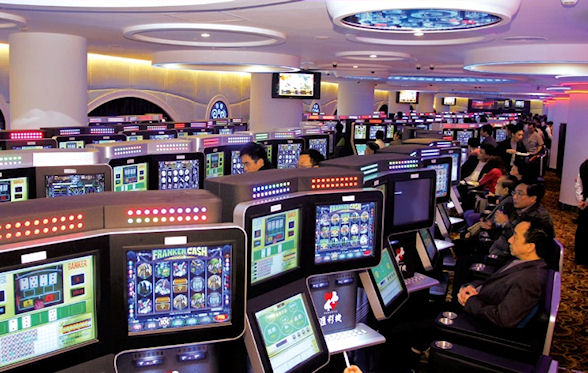
An example of hybrid gaming in Macau can be found in the products developed by local Chinese manufacturer LT Game, which allow players to bet on multiple sic bo, roulette and baccarat tables simultaneously. LT Game’s Chief Operations Officer Ms Betty Zhao said, “LT Game now has 1,921 terminals in the Macau market place. You can play these machines at 11 casinos around Macau, and you’ll be seeing more LT Game machines in Macau soon.”
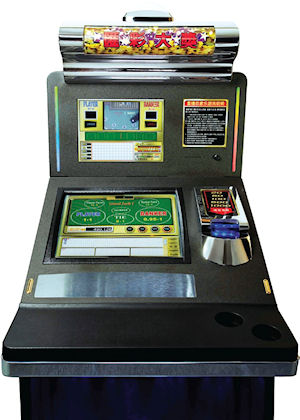 Major casinos with the LT Game product include MGM, Wynn, Sands Macau, Venetian, Sands Cotai Central and City of Dreams. LT’s machine first appeared at Kampek, where almost the entire gaming floor is given over to the hybrid model. To learn more about Kampek, check out the story about this casino in our Nov/Dec 2011 issue. Just go to wgm8.com and type “Kampek high tech” (with the quotes) in the search box.
Major casinos with the LT Game product include MGM, Wynn, Sands Macau, Venetian, Sands Cotai Central and City of Dreams. LT’s machine first appeared at Kampek, where almost the entire gaming floor is given over to the hybrid model. To learn more about Kampek, check out the story about this casino in our Nov/Dec 2011 issue. Just go to wgm8.com and type “Kampek high tech” (with the quotes) in the search box.
As well as hybrid games, e-table games developed way past what we saw in the 1990s. For example the Sabre multi-win roulette product from Inspired Gaming has no less than four roulette wheels spinning simultaneously, and players can bet on any or all of them at once. Don’t like how the first or second wheel is going? No problem, just bet on the third and fourth! To learn more about Sabre, check out our story about the game in our Jul/Aug 2011 issue. Just go to wgm8.com and type “Inspired gaming rattles its sabre” (with the quotes) in the search box.
Both e-table games and live dealer games typically have a camera feed of the table action, so it’s not necessary for the player to be able to see the dealer or even be in the same room as the dealer!
From the mid 2000s we started to see cathode ray tube screens replaced by flat screens. Just as with television technology, these flat screens are getting both bigger and better. The high definition on some of the slot screens of today is spectacular. Not only is the slot machine screen getting bigger, but the rest of the slot machine is growing too. Some of these machines are so tall they would tower over Yao Ming! Gone are the days of slot players feeling like battery hens, lined up in rows shoulder to shoulder. Games like American Idol, The Dark Knight, Wheel of Fortune and Monopoly are good examples of machines that take up more than their fair share of the gaming floor.
Another recent development is the emergence of virtual sports. If you have ever played the exciting horse racing game at Resorts World Manila you’ll know what we mean. With its stadium style terminal seating and huge multiple screens taking up an entire wall, it’s the next best thing after actually being at the races. Some people might argue it’s even better than going to the races! In August 2011, Inspired Gaming’s Virtual Sports offering became China’s first government approved rapid-draw lottery game and is currently live in National Sports Lottery venues in mainland China. Inspired’s Virtual Sports has a wide range of sports including horses, greyhound racing, soccer, motor racing and tennis.
Where to from here?
Slots and baccarat are the only two games on the casino floor that are growing in Macau. The future for both of them looks very bright. Mr Mark Michalko, Sales Director for IGT in Asia, agrees:
I’m very optimistic about the growth of slots in Macau. We’ve seen record growth of 420 percent from 2005 to 2010 – and we see good growth in the mass market over the next decade, especially with the restrictions on numbers of tables. It could increase three-fold.
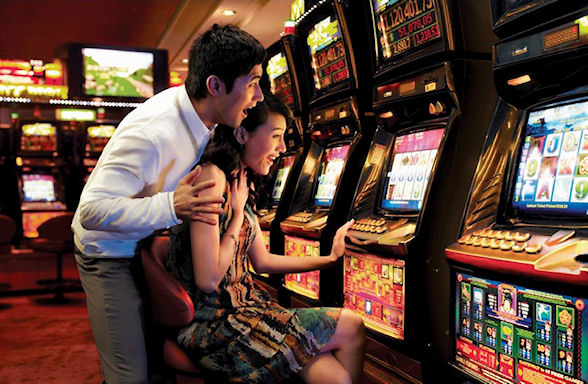
David Punter also sees a bright new future for slot development:
Technology and advances in the video gaming world are starting to find their way into the gaming floor. We’re already seeing a move toward sensory immersion – we have chairs that vibrate and screens with tactile feel. It’s not just sight and sound anymore.
| Did you know? |
| I’m easily misunderstood
Slot machines are one of the most misunderstood forms of gambling, which is surprising given they are one of the most popular gambling games in casinos worldwide. As a player it is your job to get the most bang for your buck possible! Part B explains how. Baby you and I are all the same Although they may look vastly different all slot machines essentially work the same way – with single pay line, multiple pay lines, video slots and even online slot machines sharing the same basic mathematics and computer programs behind the screen. That’s so random! Every slot machine contains a key piece of hardware called a “random number generator”, or RNG. The random numbers that determine whether you spin a winning combination or not depends on the precise moment you press the play button, pull the handle or click the mouse. Pausing for just a fraction of a second can be the difference between winning or losing. |
Don’t miss part B next issue
So far we’ve just covered the worldwide history of slots and how we got to where we are today. There’s so much more to talk about. In the next issue of WGM, we’ll feature part B of “Rise of the Machines”, in which we’ll cover topics such as:
- The history of slots in Macau
- Slot 101: How to play a slot machine
- The differences between playing table games and slots
- How Macau slot players are different to players outside Macau
- Macau’s most popular slot games
- Where to find the most popular machines and the biggest jackpots in Macau
- Slot myths busted
- New features to expect from slot machines in the future
|
World Gaming would like to thank all those who provided information for this article (including part B of the series), including: Aristocrat Macau: David Punter and Nathan Drane SHFL Entertainment: Ken Jolly, Pete Wilkins and Sandra Renwick LT Game: Betty Zhao and Carol Shu Aspect Gaming: Justin Nguyen and Tony Payne Inspired Gaming: Lucy Buckley International Game Technology: Nigel Turner and Mark Michalko Paltronics Australasia: Stephen Cowan and Kylie Rogers Transcity Asia: Chris Rogers Weike Gaming: Gus Noble and Andy Crisafi |

